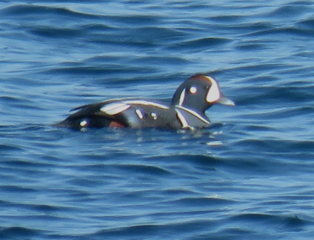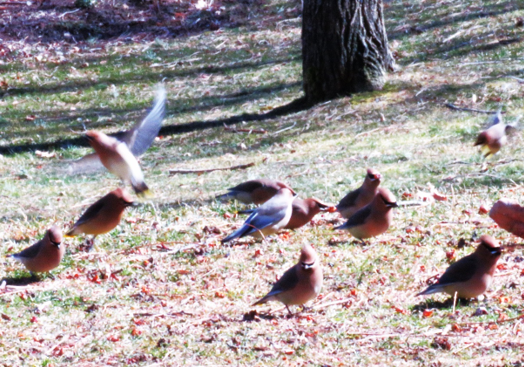Phenological Phacts and Photos w/ Carl Martland / April 2024
Spring Break
Phenology – “a branch of science concerned with the relationship between climate and periodic biological phenomena (as the migration of birds or the flowering and fruiting of plants).”
Had Enough Snow?
Last month, I asked whether anyone had had enough snow? At that time, it seemed we were in for an endless mud season, long before we had had our fill of winter. But now, beginning to work on this essay after a pleasant hour snowshoeing through 18 inches of fresh snow, I have a different perspective. We’re again experiencing the joys of winter. The drifts are three feet deep, the snow-coated evergreens stand out against a perfect blue sky, and I’ve stomped out trails through the Back 4 and along the dam. This, I thought, is wonderful, and we’ll have a few more days to enjoy the snow. And you know what? That will be enough for me! In a week or two, I’ll be waiting along with the wood frogs for the ice to open up on the pond.
Spring Break
We spent most of last week in York Harbor and Ogunquit, an excellent location for a spring break. Most of the sea birds that wintered along the rocky coast were still there, while the song birds heading back to North Country were, like us, taking a few days to enjoy the sounds of the surf and their favorite shore dinners. The tree branches were still bare, but some of the shrubs had hundreds of buds ready to burst once the warm weather truly arrives. We saw a few green shoots in the gardens by the inn, and we saw a single crocus that was almost in bloom. But it was too early for spring flowers, and it was colder by the coast than it had been in Sugar Hill for the first two weeks of March. Add a steady wind of 20 or 30 miles per hour, and you can be sure that we sometimes had to curtail our time walking along the broad beaches, the barren coastal paths, and the summit of Mount Agamenticus. Nevertheless, we enjoyed our time by the sea, and, by the calendar at least, we did have a “spring” break.
Rocky Coasts
After spending months amid the snow-covered peak of the White Mountains, it is a treat to see the ocean, especially as you walk along one of the paths that curve along the tops of the rocky outcroppings that line so much of the ocean shore in Maine. The Marginal Way in Perkins Cove in Ogunquit is one of our favorites, as you look to the right to see the rafts of eiders and scoters, look up to see the gulls, and look to the left to see elegant Victorian houses with wide porches and deep lawns (or is it “deep porches and wide lawns?”_Either way works.)
March 19, 2024. A view toward a typical rocky Maine coast from the beginning of the Marginal Way in Perkins Cove.
The most beautiful of the sea birds are the harlequin ducks, small ducks that revel in the surf breaking on the rockiest outcroppings. In February, we have seen eight or ten at a time, but this year we only saw a couple of them. Even so, a view of just one of these creatures is a highlight of the day’s adventure.
February 14, 2018. A harlequin duck floating a few yards below the Marginal Way, taking a short rest before diving once again into the surf.
Eiders and scoters were in abundance this year, both along the Marginal Way and in the little inlet by the Nubble, perhaps the most photogenic lighthouse in New England. These birds tend to gather in groups of a dozen or more, usually fifty or a hundred yards off the coast.
March 19, 2024. A couple of dozen black scoters floated near the nubble. One male invaded a group of females, but the others stayed in a separate clump a few yards away
March 19, 2014. The wonderfully scenic lighthouse at the Nubble in Ogunquit.
The male common eider is the most easily recognized of these common sea birds, because it is large and nearly all white. At a distance, black scoters and surf scoters seem to be rather lackluster dark birds that are content with just floating along, only occasionally diving for a snack. Up close, or in the telephoto lens, you can appreciate their most remarkable feature. Like Jimmy Durante, their personality can be dominated by their magnificent beaks.
February 14, 2018. One of many common eiders viewed at a distance from the Marginal Way
February 15, 2018. A surf scoter makes up for its drab feathers with its colorful beak and forehead.
Eiders, scoters, and sea gulls all contribute to a pleasant walk along the coast, but those of us from the North Country hope to see one of our own in its winter setting. So, when we saw a couple of loons this year, we got very excited, even though they were too far away for a photo like the one I took back in 2018.
February 15, 2018. A juvenile loon spreads its wings just off York Harbor. It probably can’t wait to get back to Pearl Lake in Lisbon or perhaps to one of the Connecticut Lakes.
Migrating Song Birds
As noted above, mid-March was a great time to see some migrating song birds. Most mornings, in the little park across from our inn, we could see robins and song sparrows as we sat at our favorite bench looking out across a lawn that sloped down to the sea. I was happy one day to get a photo of a robin sitting barely twenty feet in front our bench, alternating between looking for an insect in the grass and then turning to gaze, as we were gazing, at the gulls and ducks flying above and floating on the sparkling bay.
March 19, 2024. A lone cardinal called from high above in one of the trees that lined the Marginal Way. It called again, from a different spot. Where is it? There, almost to the top of the tree on the left? Yes! Can I get a photo? Yes! Can I get a good photo? No, it flew away
However, the highlight of our coastal bird-watching this year was the flock of several dozen waxwings that frolicked day after day in the cherry trees right across the street from our inn. We love the regal plumage and elegant manner of these birds, and we always are excited when a little flock stops by our pond on their way north in the spring and stops by again in the fall to feed on the berries in the viburnum bushes at the edge of the Upper Meadow. But we only see little flocks here in Sugar Hill, never more than a dozen birds. Until last week, we never imagined that we could walk within a few feet of a flock of three dozen of them filling up on the dried cherries that remained in the trees and littered the ground beside the paved path where we stood still, basking in and sharing their excitement.
March 21, 2024. A flock of three dozen cedar waxwings feasted on the dry cherries that littered the ground in the little park across the street from the York Harbor Inn.
With so many of these beautiful birds hanging around day after day, it wasn’t too difficult to get a special photo. This photo of a waxwing about to take off shows that we really were seeing flashes of yellow as they flitted from branch to branch picking out the best cherries.










